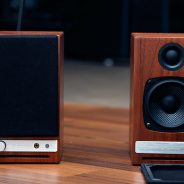The relationship between speaker size and sound
Aug 30
Some people think that speaker size doesn’t matter, but it does. We have found the optimum size for a speaker to be 10 inches or larger, and this is because of the way sound waves behave in different environments.
Larger speakers can produce louder sounds than smaller ones can, which means they will be heard better by more listeners at once. That is why you should always go with the largest possible speaker if you want your music to be heard as clearly as possible!
Can small speakers sound as good as large?
In many cases, the answer is yes! A small speaker may not produce as much sound, but it will hit a certain range of frequencies particularly well. So, for example, if you listen mainly to classical music and do not need your speakers for an EDM party, then you can probably get away with buying smaller floor standing or bookshelf speakers.
If you need a lot of bass volume, it is better to look for speakers with an abundance of subs. On the other hand, if your space can fit the large speaker, go ahead and buy big because the sound will be much more powerful!
The size should also match with how far away listeners are from the speakers. For example, if you want people sitting around a table to hear the music, your speakers should be smaller, like computer speakers.
If you would like listeners to hear it as they walk around, the speakers should be larger. Do not forget about your room size when purchasing a speaker! If you have an overly large space for a small sound system, it might seem better than having no music at all. However, if you purchase big floor standing speakers and place them in a small room, it will sound terrible.
How does speaker shape affect the sound?
A speaker’s shape has a big impact on the sound. For example, speakers tall and narrow, such as bookshelf speakers, have better low-frequency output than shorter heights or wider widths. It is because long wavelengths require more space to vibrate freely compared to short wavelengths. In this way, when you look at a bookshelf speaker, you can easily see how the size of the cabinet might influence bass response.
The speakers that are wider and shorter than average tend to have more directional output, which is ideal for surround sound systems because it helps with localization. Smaller speakers do not project as well – they’re better suited for desks and near-field listening.
The shape of the speaker will also influence how well it projects to different rooms and angles. The ideal sound should be heard by everyone in every corner of a room, but that’s not always possible with certain shapes. Some speakers can only project their sound better from one location or angle due to varying factors such as driver placement or speaker design.
The size of the speakers is important to consider when deciding where they will be placed in a room and what kind of listening experience you want them to provide. For example, tall, narrow speakers are known for better bass response, while wide, short ones excel at projecting sound over long distances, regardless of the space between speakers and listeners.
Speaker shape has a large impact on sound quality, but consumers who are shopping for new speakers or looking to upgrade their existing ones are often overlooked.
